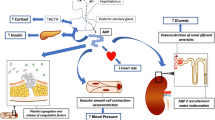Abstract
Vasopressin was used in ten critically ill patients with massive intra-abdominal bleeding unresponsive to conventional therapy. Vasopressin controlled bleeding in four patients, three of whom had continued to bleed following laparotomy for haemostasis; in two other patients, bleeding was reduced. All the patients were intensively monitored throughout the period of the vasopressin treatment; this enabled other physiological effects of vasopressin to be documented and reported. Mean arterial pressure and central venous pressure increased following the administration of vasopressin and there was a decrease in heart rate. Core body temperature rose significantly. Although all the patients had impaired renal function before receiving vasopressin, five had a prompt diuresis following its administration. Eight patients died but only three of intra-adbominal bleeding; two patients survived to leave hospital. Four patients had post-mortem evidence of ischaemia in the heart, liver and gastrointestinal tract; vasopressin may have contributed to the development of this. Vasopressin may have a place in the management of patients with life-threatening intra-abdominal haemorrhage but its use should be confined to those patients in whom conventional therapy has failed.
Similar content being viewed by others
References
Clark GA (1928) Comparison of the effects of adrenalin and pituitrin on the portal circulation. J Physiol 66:274
Melson GL, Geisse G, Stanley RJ (1976) Selective intraarterial infusion of vasopressin for control of gastrointestinal bleeding: experience with 35 cases. Gastrointest Radiol 1:59
Millette B, Huet P-M, Lavoie P, Viallet A (1975) Portal and systemic effects of selective infusion of vasopressin into the superior mesenteric artery in cirrhotic patients. Gastroenterology 69:6
Barr JW, Lakin RC, Rosch J (1975) Similarity of arterial and intravenous vasopressin on portal and systemic hemodynamics. Gastroenterology 69:13
Johnson WC, Wildrich WC, Ansell JE, Robbins AH, Nabseth DC (1977) Control of bleeding varces by vasopressin: a prospective randomised study. Ann Surg 186:369
Shaldon S, Sherlock S (1960) The Use of Vasopressin (Pitressin) in the control of bleeding from oesophageal varices. Lancet II:222
Kehne JH, Hughes FA, Gompertz ML (1956) The use of surgical pituitrin in the control of esophageal varix bleeding. Surgery 39:917
Conn HO, Dalessio DJ (1962) Multiple infusions of posterior pituitary extract in the treatment of bleeding esophageal varices. Ann Intern Med 57:805
Hussey KP (1985) Vasopressin therapy for upper gastrointestinal tract hemorrhage. Arch Intern Med 145:1263
Eiseman B, Silen W, Tyler P, Earley T (1960) The portal hypotensive action of pituitrin. Surgical Forum 10:286
Drapanas T, Crowe CP, Shim WKT, Worthington GS (1961) The effect of pitressin on cardiac output and coronary, hepatic and intestinal blood flow. Surg Gynecol Obstet:484
Nusbaum M (1975) Arterial vasopressin infusions: science or seance? Gastroenterology 69:263
Silva YJ, Moffat RC, Walt AJ (1969) Vasopressin effect on portal and systemic hemodynamics. JAMA 210:1065
Shelly MP, Robinson AA, Hesford JW, Park GR (1987) The haemodynamic effects following surgical release of raised intraabdominal pressure. Br J Anaesth 59:800
Edmunds R, West JP (1962) A study of the effect of vasopressin on portal and systemic blood pressure. Surg Gynaecol Obstet 459
Bynum TE, Fara JW (1980) Hepatic artery response to vasopressin. Am J Physiol 239:378
Hanson KM (1970) Vascular response of intestine and liver to intravenous infusion of vasopressin. Am J Physiol 219:779
Greenaway CV (1983) Role of splanchnic venous system in overall cardiovascular homeostasis. Fed Proc 42:1678
Slotnik IL, Tiegland JD (1951) Cardiac accidents following Vasopressin injection (Pitressin). JAMA 146:1126
Ruskin A (1947) Pitressin test of coronary insufficiency. Am J Heart 34:569
Roberts C, Maddison FE (1976) Partial mesenteric arterial occlusion with subsequent ischaemic bowel damage due to Pitressin infusion. Am J Roentgenol 126:829
Beradi RS (1974) Vascular complications of superior mesenteric artery infusion with Pitressin in treatment of bleeding varices. Am J Surg 127:757
Renert WA, Button KF, Fuid SL, Casarella WJ (1972) Mesenteric venous thrombosis and small bowell infarction following infusion of vasopressin into the superior mesenteric artery. Radiology 102:299
Collins EN, Root JC (1936) Elimination of confusing gas shadows during cholecystography by the use of Pitressin. JAMA 107:32
Author information
Authors and Affiliations
Rights and permissions
About this article
Cite this article
Shelly, M.P., Greatorex, R., Calne, R.Y. et al. The physiological effects of vasopressin when used to control intra-abdominal bleeding. Intensive Care Med 14, 526–531 (1988). https://doi.org/10.1007/BF00263525
Received:
Accepted:
Published:
Issue Date:
DOI: https://doi.org/10.1007/BF00263525




